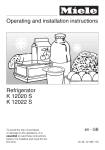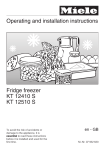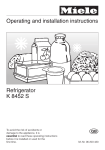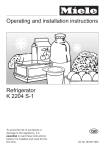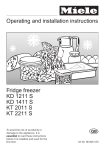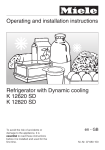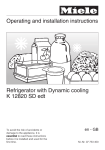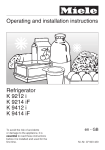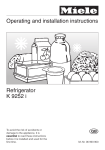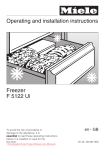Download Operating and installation instructions Built-in refrigerator K 121 Ui (-1)
Transcript
Operating and installation instructions Built-in refrigerator K 121 Ui (-1) To avoid the risk of accidents or damage to the appliance, it is essential to read these instructions before it is installed and used for the first time. en - GB, HK M.-Nr. 07 371 501 Contents Guide to the appliance . . . . . . . . . . . . . . . . . . . . . . . . . . . . . . . . . . . . . . . . . . . . . 4 Caring for the environment . . . . . . . . . . . . . . . . . . . . . . . . . . . . . . . . . . . . . . . . . . 5 Warning and Safety instructions . . . . . . . . . . . . . . . . . . . . . . . . . . . . . . . . . . . . . 6 How to save energy . . . . . . . . . . . . . . . . . . . . . . . . . . . . . . . . . . . . . . . . . . . . . . . 10 Switching on and off . . . . . . . . . . . . . . . . . . . . . . . . . . . . . . . . . . . . . . . . . . . . . . 11 Switching off for longer periods of time . . . . . . . . . . . . . . . . . . . . . . . . . . . . . . . . . 11 The correct temperature . . . . . . . . . . . . . . . . . . . . . . . . . . . . . . . . . . . . . . . . . . . 12 . . . in the refrigerator . . . . . . . . . . . . . . . . . . . . . . . . . . . . . . . . . . . . . . . . . . . . . . . 12 Setting the temperature . . . . . . . . . . . . . . . . . . . . . . . . . . . . . . . . . . . . . . . . . . . . . 12 Using the refrigerator efficiently . . . . . . . . . . . . . . . . . . . . . . . . . . . . . . . . . . . . 13 Different storage zones . . . . . . . . . . . . . . . . . . . . . . . . . . . . . . . . . . . . . . . . . . . . . 13 Food which should not be stored in a refrigerator. . . . . . . . . . . . . . . . . . . . . . . . . 13 Storing food correctly . . . . . . . . . . . . . . . . . . . . . . . . . . . . . . . . . . . . . . . . . . . . . . 14 Unpacked meats and vegetables . . . . . . . . . . . . . . . . . . . . . . . . . . . . . . . . . . 14 Protein rich foods . . . . . . . . . . . . . . . . . . . . . . . . . . . . . . . . . . . . . . . . . . . . . . . 14 Meat . . . . . . . . . . . . . . . . . . . . . . . . . . . . . . . . . . . . . . . . . . . . . . . . . . . . . . . . . 14 Adjusting the interior fittings . . . . . . . . . . . . . . . . . . . . . . . . . . . . . . . . . . . . . . . 15 Moving the shelves . . . . . . . . . . . . . . . . . . . . . . . . . . . . . . . . . . . . . . . . . . . . . . . . 15 Split shelf . . . . . . . . . . . . . . . . . . . . . . . . . . . . . . . . . . . . . . . . . . . . . . . . . . . . . . . . 15 Adjusting the door shelves/bottle shelf . . . . . . . . . . . . . . . . . . . . . . . . . . . . . . . . . 15 Automatic defrost . . . . . . . . . . . . . . . . . . . . . . . . . . . . . . . . . . . . . . . . . . . . . . . . 16 Cleaning and care . . . . . . . . . . . . . . . . . . . . . . . . . . . . . . . . . . . . . . . . . . . . . . . . 17 Cleaning the interior and accessories . . . . . . . . . . . . . . . . . . . . . . . . . . . . . . . . . . 17 Ventilation gaps . . . . . . . . . . . . . . . . . . . . . . . . . . . . . . . . . . . . . . . . . . . . . . . . . . . 17 Door seal . . . . . . . . . . . . . . . . . . . . . . . . . . . . . . . . . . . . . . . . . . . . . . . . . . . . . . . . 17 Problem solving guide . . . . . . . . . . . . . . . . . . . . . . . . . . . . . . . . . . . . . . . . . . . . 19 Noises . . . . . . . . . . . . . . . . . . . . . . . . . . . . . . . . . . . . . . . . . . . . . . . . . . . . . . . . . 21 After Sales / Guarantee . . . . . . . . . . . . . . . . . . . . . . . . . . . . . . . . . . . . . . . . . . . . 22 Electrical connection . . . . . . . . . . . . . . . . . . . . . . . . . . . . . . . . . . . . . . . . . . . . . . 23 Installation . . . . . . . . . . . . . . . . . . . . . . . . . . . . . . . . . . . . . . . . . . . . . . . . . . . . . . 24 Location . . . . . . . . . . . . . . . . . . . . . . . . . . . . . . . . . . . . . . . . . . . . . . . . . . . . . . . . . 24 Climate range . . . . . . . . . . . . . . . . . . . . . . . . . . . . . . . . . . . . . . . . . . . . . . . . . . 24 Ventilation . . . . . . . . . . . . . . . . . . . . . . . . . . . . . . . . . . . . . . . . . . . . . . . . . . . . . . . 24 Before installation . . . . . . . . . . . . . . . . . . . . . . . . . . . . . . . . . . . . . . . . . . . . . . . . . 24 Building in dimensions . . . . . . . . . . . . . . . . . . . . . . . . . . . . . . . . . . . . . . . . . . . 25 Contents Changing the door hinging . . . . . . . . . . . . . . . . . . . . . . . . . . . . . . . . . . . . . . . . . 26 Installing the appliance . . . . . . . . . . . . . . . . . . . . . . . . . . . . . . . . . . . . . . . . . . . . 27 Weight of the furniture door . . . . . . . . . . . . . . . . . . . . . . . . . . . . . . . . . . . . . . . . . . 27 Installation . . . . . . . . . . . . . . . . . . . . . . . . . . . . . . . . . . . . . . . . . . . . . . . . . . . . . . . 27 Fitting the plinth . . . . . . . . . . . . . . . . . . . . . . . . . . . . . . . . . . . . . . . . . . . . . . . . . . . 29 Fitting a furniture door . . . . . . . . . . . . . . . . . . . . . . . . . . . . . . . . . . . . . . . . . . . . . . 31 Drilling positions on framed doors . . . . . . . . . . . . . . . . . . . . . . . . . . . . . . . . . . 31 Aligning the furniture door . . . . . . . . . . . . . . . . . . . . . . . . . . . . . . . . . . . . . . . . . . . 32 Guide to the appliance a Light contact switch g Butter and cheese compartment b Temperature selector and interior lighting h Egg trays c Adjustable shelves d Condensate channel and drain hole e Fruit and vegetable compartment f Ventilation gaps 4 i Bottle shelf Caring for the environment Disposal of the packing material The transport and protective packing has been selected from materials which are environmentally friendly for disposal, and should be recycled. Ensure that any plastic wrappings, bags etc. are disposed of safely and kept out of the reach of babies and young children. Danger of suffocation! Disposal of your old appliance Electrical and electronic appliances often contain materials which, if handled or disposed of incorrectly, could be potentially hazardous to human health and to the environment. They are, however, essential for the correct functioning of your appliance. Please do not therefore dispose of it with your household waste. Please dispose of it at your local community waste collection / recycling centre or contact your dealer for advice. Ensure that it presents no danger to children while being stored for disposal. Take care not to damage the pipework at the back of it before or during transportation to an authorised collection depot. In this way, refrigerant in the pipework and oil in the compressor will be contained, and will not leak out into the environment. 5 Warning and Safety instructions This appliance complies with all relevant legal safety requirements. Improper use of the appliance can, however, present a risk of both personal injury and material damage. To avoid the risk of accidents and damage to the appliance, please read these instructions carefully before installation and before using it for the first time. They contain important notes on the installation, safety, operation and care of the appliance. Keep these instructions in a safe place and pass them on to any future user. Correct application ~ This appliance is not designed for commercial use. It is intended for use in domestic households and in similar working and residential environments such as: – Shops – Offices and showrooms and by residents in establishments such as – Hostels and guest houses. It must only be used as a domestic appliance to cool and store foodstuffs. Any other usage is not supported by the manufacturer and could be dangerous. Miele cannot be held liable for damage resulting from incorrect or 6 improper use or operation of the appliance. ~ This appliance is not intended for use by persons (including children) with reduced physical, sensory or mental capabilities, or lack of experience and knowledge, unless they are supervised whilst using it, or have been shown how to use it correctly by a person responsible for their safety. Safety with children ~ This appliance is not a toy! To avoid the risk or injury, do not allow children to play on or near it, or to play with the controls. Please supervise young children whilst you are using it. Older children may only use the appliance if its operation has been clearly explained to them and they are able to use it safely, recognising the dangers of misuse. Warning and Safety instructions Technical safety ~ Before setting up the appliance, check it for any externally visible damage. Do not install and use a damaged appliance. ~ The more coolant there is in an appliance, the larger the room it should be installed in. In the event of a leakage, if the appliance is in a small room, there is the danger of combustible gases building up. For every 8 g of coolant at least 1 m3 of room space is required. The amount of coolant in the appliance is stated on the data plate inside the appliance. ~ Before connecting the appliance to ~ This appliance contains the coolant Isobutane (R600a), a natural gas which is environmentally friendly. Although it is flammable, it does not damage the ozone layer and does not increase the greenhouse effect. The use of this coolant has, however, led to a slight increase in the noise level of the appliance. In addition to the noise of the compressor, you might be able to hear the coolant flowing around the system. This is unavoidable, but does not have any adverse effect on the performance of the appliance. Care must be taken during the transportation and setting up of the appliance that no parts of the cooling system are damaged. Leaking coolant can be harmful to the eyes. In the event of any damage: - avoid open fires and anything which creates a spark, - disconnect from the mains, - air the room in which the appliance is located for several minutes and - contact the Service Department for advice. the mains supply, make sure that the rating on the data plate corresponds to the voltage and frequency of the household supply. This data must correspond in order to avoid the risk of damage to the appliance. Consult a qualified electrician if in any doubt. ~ The electrical safety of this appliance can only be guaranteed when continuity is complete between it and an effective earthing system which complies with current local and national safety regulations. It is most important that this basic safety requirement is present and tested regularly, and where there is any doubt, the household wiring system should be inspected by a qualified electrician. The manufacturer cannot be held liable for damage or injury caused by the lack of or inadequacy of an effective earthing system (e.g. electric shock). ~ If the connection cable is faulty it must only be replaced by a Miele approved service technician to protect the user from danger. 7 Warning and Safety instructions ~ Safe operation of the appliance is only assured if it has been installed and connected in accordance with these operating and installation instructions. ~ This equipment may only be used in mobile installations such as ships, caravans, aircraft etc. if a risk assessment of the installation has been carried out by a suitably qualified engineer. ~ Installation work, maintenance and repairs may only be carried out by suitably qualified and competent persons in accordance with national and local safety regulations. Repairs and other work by unqualified persons could be dangerous and the manufacturer will not be held liable. Ensure current is not supplied to the appliance until after maintenance or repair work has been carried out. ~ The appliance is only completely isolated from the electricity supply when: – it has been switched off at the wall socket and the plug has been withdrawn, – the mains fuse is withdrawn, or – the screw-out fuse is removed in countries where this is applicable. ~ Do not connect the appliance to the mains electricity supply by an extension lead. Extension leads do not guarantee the required safety of the machine (e.g. danger of overheating). 8 ~ In countries where there are areas which may be subject to infestation by cockroaches or other vermin, pay particular attention to keeping the appliance and its surroundings in a clean condition at all times. Any damage which may be caused by cockroaches or other vermin will not be covered by the guarantee. Correct use ~ Never store explosive materials in the appliance or any products containing propellants (e.g. spray cans). Thermostats switching on may produce sparks which could present a fire hazard. Flammable compounds could explode. ~ Do not operate any electrical equipment (e.g. an electric ice-cream maker) inside the appliance. Danger of sparking and explosion. ~ If storing alcohol with a high percentage proof, make sure it is tightly closed and stored upright. Danger of explosion. ~ Observe the "use by" dates given on food to avoid the risk of food poisoning. Storage times will depend on several factors, including the freshness and quality of the food as well as the temperature at which it is stored. Follow the instructions given on the food manufacturer’s packaging on storage conditions required. Warning and Safety instructions ~ Do not use sharp edged objects to – remove frost and ice, – separate food which has become frozen. They will damage the evaporator, causing irreversible damage to the appliance. ~ Do not use defrosting sprays or de-icers, as they might contain substances which could damage the plastic parts or which could cause a build-up of gases and pose a danger to health. ~ Do not use any oils or grease on the door seal as these will cause the seal to become porous with time. ~ Do not store cooking oil in the refrigerator door. Traces of oil can cause stress cracks to occur in the plastic components in the door. ~ Do not block the ventilation gap in the plinth or the top of the appliance housing unit as this would impair the efficiency of the appliance, increase the electricity consumption and could cause damage to the appliance. ~ The appliance is designed for use within certain climate ranges (ambient temperatures), and should not be used outside this range. The climate range for your appliance is stated on the data plate inside the appliance. Installing it in a room with too low an ambient temperature, e.g. a garage, can lead to the appliance switching off for longer periods so that it cannot maintain the required temperature. ~ Never use a steam-cleaning appliance to clean this appliance. Pressurised steam could reach the electrical components and cause a short circuit. Disposal of your old appliance ~ Before disposing of an old appliance first make the door latch or lock unusable. This way you will prevent children from accidentally locking themselves in and endangering their lives. ~ Be careful not to damage any part of the pipework whilst awaiting disposal, e.g. by – puncturing the refrigerant channels in the evaporator. – bending any pipework. – scratching the surface coating. Splashes of refrigerant can damage the eyes. The manufacturer cannot be held liable for damage caused by non-compliance with these Warning and Safety instructions. 9 How to save energy Normal energy consumption Increased energy consumption In a ventilated room. In an enclosed, unventilated room. Protected from direct sunlight. In direct sunlight. Not situated near to a heat source (radiator, oven). Situated near to a heat source (radiator, oven). Where the ideal ambient room temperature is approx. 20°C. Where there is a high ambient room temperature. Temperature setting with a thermostat which is approximate (set in stages). With a medium setting of 2 to 3. With a high setting: the lower the temperature in the compartment, the higher the energy consumption. Temperature setting with a thermostat which is exact to the degree (digital display). Cellar section 8 to 12°C Installation site On appliances with winter setting, please make sure that the winter PerfectFresh zone just above 0 °C setting is switched off when the ambient temperature is warmer Freezer section -18°C than 16 °C. Refrigerator section 4 to 5 °C Wine storage section 10 to 12 °C Use Only open the doors when necessary and for as short a time as possible. Frequent opening of the doors for long periods will cause a loss of coldness. Store food in an organised way. If food is not stored in an organised way, searching for an item will mean the door is open for longer. Allow hot food and drinks to cool down before placing them in the appliance. Placing hot food in the appliance will cause the compressor to run for a long time, as the appliance will have to work harder to lower the temperature. Store food covered or packaged. The evaporation or condensation of liquids will cause a loss of coldness in the refrigerator. Place frozen food in the refrigerator to defrost. Do not over-fill the appliance to allow air to circulate. Defrosting 10 Defrost the freezer compartment when a layer of ice 0.5 cm thick has built up. A layer of ice hinders the cold from reaching the frozen food, and causes an increase in energy consumption. Switching on and off Before using for the first time Switching off ^ Remove the transit fitting from the appliance, and dispose of it. ^ Turn the temperature selector in an anti-clockwise direction from "1" back to the "0" position. You will feel a slight resistance, but this should be ignored. ^ Place the stopper supplied in the empty hole. ^ Clean the inside of the appliance and the accessories with luke warm water and a little washing-up liquid, and then dry with a soft cloth. Important: To ensure the correct functioning of the appliance, let it stand for between ½ and 1 hour after transporting it to its final location before connecting it to the mains. Switching on The cooling system and the interior lighting are now switched off. Switching off for longer periods of time If the appliance is not going to be used for a longer period of time, e.g. whilst on holiday, ^ switch the appliance off, ^ switch off at the wall socket and withdraw the plug, ^ clean the appliance out and ^ leave the door ajar to air the appliance. ^ Turn the temperature selector in a clockwise direction away from "0". The appliance will start to cool, and the interior lighting will come on when the door is opened. If, during a long absence, the appliance is switched off but not cleaned out and the door is left shut, there is a danger of mould and odours building up inside the appliance. The higher the setting, the lower the temperature in the appliance. 11 The correct temperature It is very important to set the correct temperature for storing food in the appliance. Micro-organisms will cause food which is not stored at the correct temperature to deteriorate rapidly. Temperature influences the growth rate of these micro-organisms. Reducing the temperature reduces their growth rate. The temperature in the appliance will rise: Please note the following: – household thermometers and those used for measuring the temperature of bathwater are not very accurate. It is best to use an electronic thermometer. – Do not measure the temperature of the air in the appliance. The result will not reflect the temperature in the food. – if too much food is stored in it at once, – Try to open the door as little as possible during the measuring period, as warm room air will enter the refrigerator every time the door is opened. – the warmer the food is which is being put into it, Setting the temperature – the more often the door is opened and the longer it is kept open, – the higher the ambient temperature surrounding the appliance. The appliance is designed for use in specific ambient temperatures (climate ranges). Do not use in ambient temperatures for which it is not designed. . . . in the refrigerator We recommend a temperature of 4 °C in middle of the refrigerator. If you wish to check the temperature in the refrigerator, ^ place a thermometer in a glass of water and then place the glass in the middle of the refrigerator section. After about 24 hours, the thermometer will show the approximate temperature in the refrigerator. 12 The temperature is set using the temperature dial. ^ Turn it to a setting between 1 and 5. The higher the setting, the lower the temperature in the appliance. A middle range setting is usually sufficient. It is advisable to select a high setting for a short period if the door is opened frequently, large quantities of food are being stored in the refrigerator or there is a high ambient temperature. Using the refrigerator efficiently Different storage zones Due to the natural circulation of the air in the appliance, there are different temperature zones in the refrigerator. Cold, heavy air sinks to the lowest section of the appliance. Make use of the different zones when placing food in the appliance. Warmest area The warmest area is in the top section of the door. Use this for storing butter and cheese. Coldest area The coldest area in a refrigerator is directly above the vegetable containers. Use this for all delicate and highly perishable food, e.g. – fish, meat, poultry, – sausage products, ready meals, – dishes or baked goods containing eggs or cream, – fresh dough, cake mixtures, pizza or quiche dough, – soft cheese and other dairy products, – pre-packed vegetables and other fresh food with a label stating it should be kept at a temperature of approx. 4°C. Do not store explosive materials in the appliance or any products containing propellants (e.g. spray cans). Danger of explosion. If storing alcohol with a high percentage proof, make sure it is tightly closed, and store upright. If storing bottles of oil or food containing high levels of fat or oil in the appliance, take care not to let the fat or oil come into contact with plastic components. These can cause stress cracks to occur in the plastic components. Food must not touch the back wall of the appliance, as it may freeze to the back wall. Food which should not be stored in a refrigerator Not all food is suitable for storing in the refrigerator. These include: – Fruit and vegetables which are sensitive to cold, such as bananas, avocado pears, papaya, passion fruit, aubergines/eggplant, peppers/capsicum, tomatoes and cucumbers – Fruit which is not yet ripe – Potatoes – Some hard cheeses, e.g. Parmesan 13 Using the refrigerator efficiently Storing food correctly Unpacked meats and vegetables Store food covered or packaged. This will prevent food smells or tastes from affecting other foods, and prevent food from drying out and also any cross-contamination of bacteria. The growth of bacteria, such as salmonella, can be avoided by setting the correct temperature and maintaining good standards of hygiene. Different types of unpacked meats and vegetables must be kept separate. To avoid any microbiological cross-contamination, these foods may only be stored together if they are wrapped. Fruit and vegetables Fruit and vegetables can be stored loose in the vegetable containers. However, you should bear in mind that some types of vegetables give off a natural gas which speeds up the rate at which food perishes. Some fruit and vegetables react strongly to this gas and should not be stored together. Examples of fruit which produce a large amount of this natural gas are: Apples, apricots, pears, nectarines, peaches, plums, avocado pears and figs. Examples of fruit and vegetables which react strongly to the natural gases given off by other types of fruit and vegetables are: Kiwis, broccoli, cauliflower, Brussels sprouts, mangos, honeydew melons, apples, apricots, cucumbers, tomatoes, pears, nectarines and peaches. 14 Protein rich foods Please note that foods rich in protein deteriorate faster than others. Shell fish, for example, deteriorates faster than fish, and fish deteriorates faster than meat. Meat Meat should be stored loosely covered in suitable containers or packaging. Allowing the surface of the meat to dry slightly helps to prevent the growth of bacteria. To prevent the risk of bacterial cross-contamination meat should not be allowed to come into contact with other foods. Adjusting the interior fittings Moving the shelves The shelves can be adjusted according to the height of the food. ^ Pull the shelf forwards and then tilt it downwards to remove it. ^ With the rear barrier facing upwards, place the shelf at the required position. The rear barrier must face upwards to prevent food from touching the back of the appliance and freezing to it. Split shelf In order to accommodate tall items in the appliance, one of the shelves is divided. The front section of the shelf can be pushed under the rear section. Adjusting the door shelves/bottle shelf ^ Push the door/bottle shelf upwards, then lift it out. ^ Replace the door/bottle shelf at the required position. Ensure that it is securely pushed back into position. Fruit and vegetable compartment ^ To access the fruit and vegetable compartment, slide the cover to the compartment forwards. To remove the cover completely, slide it forwards as far as it will go, then lift it out. ^ Lift the front section of the shelf forwards slightly, and then push it carefully back on the guide under the rear section. 15 Automatic defrost The refrigerator defrosts automatically. Condensate and frost can build up on the back wall of the refrigerator whilst it is in use. You do not need to remove this, as it will defrost and evaporate automatically with the warmth generated by the appliance. The condensate is drained away via a channel and drain hole into an evaporation system at the back of the appliance. Ensure that the condensate channel and drain hole are kept clean and are never blocked so that condensate can flow away without hindrance. 16 Cleaning and care Never use cleaning agents containing abrasive substances such as sand, soda, acids or chemical solvents. "Non-abrasive" cleaning agents are also unsuitable as they can cause matt areas to appear. Make sure that water cannot get into the light. Do not let water get into the drainage channel and drain hole when cleaning. Do not use steam cleaning apparatus to clean the appliance. Steam could reach the electrical components and cause a short circuit. The data plate located inside the appliance must not be removed. It contains information which is required in the event of a service call. Before cleaning ^ Switch the appliance off by turning the temperature selector to "0" and then switching off at the socket and removing the plug. ^ Take any food out of the appliance and store it in a cool place. ^ Take out any removable parts, e.g. shelves, for cleaning. Cleaning the interior and accessories Use warm water with a little washing up liquid. Accessories and shelves should all be hand-washed only. ^ Clean the appliance at least once a month. ^ Clean the condensate channel and drain hole frequently, so that condensate can drain away unhindered. Use a straw or similar to clear the drain if necessary. ^ After cleaning, wipe the interior and accessories with a damp cloth and dry with a soft cloth. Leave the door open to air the appliance for a short while. Ventilation gaps ^ The ventilation gaps should be cleaned on a regular basis with a brush or vacuum cleaner. A build up of dust will increase the appliance’s energy consumption. Door seal Do not use any oils or grease on the door seal as these will cause the seal to deteriorate and become porous over time. The door seal should be cleaned regularly with clean water and then wiped dry with a soft cloth. 17 Cleaning and care After cleaning ^ Replace all shelves and accessories in the appliance. ^ Insert the plug in the socket and switch the appliance back on using the temperature selector. ^ Place food back in the appliance and close the door. 18 Problem solving guide Repairs to electrical appliances should only be carried out by a suitably qualified and competent person in strict accordance with current local and national safety regulations. Repairs and other work by unqualified persons could be dangerous. The manufacturer cannot be held liable for unauthorised work. What to do if . . . . . . the appliance does not get cool. ^ Make sure that the temperature selector is not set at "0". ^ Check that the plug is correctly inserted in the socket and switched on. ^ Check that the fuse is not defective and that the mains fuse has not blown. If it has, contact the Miele Service Department. . . . the appliance is switching in too frequently and for too long. ^ Check whether the ventilation gaps at the bottom of the appliance have been covered over or become too dusty. ^ The door has been opened too frequently, or a large amount of fresh food has been put in at once. ^ Check that the door has been closed properly. . . . the interior light is not working. ^ Has the contact switch become stuck? If this is not the case, then the lamp is defective. ^ Disconnect the appliance from the mains. Switch off at the wall and withdraw the plug from the socket, or disconnect the mains fuse or remove the screw-out fuse in countries where this is applicable. . . . the temperature in the refrigerator is too low. ^ Turn the temperature selector to a setting closer to "0". ^ Reach under the back of the light cover, and pull the cover off. ^ Unscrew the lamp by turning it clockwise, and replace it with a new one. Lamp specification: 220 - 240 V, max. 15 W, E 14 fitting. 19 Problem solving guide ^ Replace the cover. . . . the floor is wet. The drain hole is blocked. ^ Clean the condensate channel and drain hole. If you still cannot remedy the fault having followed these suggestions, please contact the Miele Service Department. To prevent unnecessary loss of temperature it is advisable not to open the door while waiting for the appliance to be serviced. 20 Noises Normal noises What causes them Brrrrr... Humming noise made by the motor (compressor). This noise can get louder for brief periods when the motor is switching on. Blubb, blubb.... A gurgling noise can be heard when coolant is circulating through the pipes. Click.... Clicking sounds are made when the thermostat switches the motor on and off. Sssrrrrr.... On multi-zone and frost-free appliances you can sometimes just hear the movement of air circulating inside the appliance. Creak ... Creaking sounds can be heard when material inside the appliance expands. Remember that the noise of the compressor and the coolant circulating in the system is unavoidable. Noises that you can easily rectify What causes them, and what can you do about them Rattling, vibrating The appliance is uneven: Realign the appliance using a spirit level, by raising or lowering the screw feet underneath the appliance. The appliance is touching another appliance or piece of furniture: Move it away. Drawers, baskets or shelves are unstable or sticking: Check all removable items and refit them correctly. Are any bottles or containers unstable or knocking against each other? Separate them. The transport cable clips are hanging loose at the back of the appliance: Remove the clips. 21 After Sales / Guarantee In the event of a fault which you cannot correct yourself, or if the appliance is under guarantee, please contact: – your Miele Dealer or – Miele (see back cover for contact details). When contacting your Dealer or Miele, please quote the model and serial number of your appliance. This information is given on the data plate inside your appliance. Please note that telephone calls may be monitored and recorded for training purposes. N.B. A call-out charge will be applied for service visits where the problem could have been resolved as described in these instructions. Guarantee For information on the appliance guarantee specific to your country please contact Miele. See back cover for contact details. In the U.K. your appliance is guaranteed for 2 years from the date of delivery. However, you must activate your cover by calling 0845 365 6640 or registering online at www.miele.co.uk. 22 Electrical connection Electrical connection U.K. Non-rewireable plugs (BS 1363) All electrical work should be carried out by a suitably qualified and competent person in strict accordance with current local and national safety regulations (BS 7671 in the UK). The fuse cover must be re-fitted when changing the fuse, and if the fuse cover is lost, the plug must not be used until a suitable replacement is obtained. The colour of the correct replacement cover is that of the coloured insert in the base of the plug, or the colour that is embossed in words in the base of the plug (as applicable to the design of the plug fitted). The appliance is supplied with a mains cable and moulded plug ready for connection to an a.c. single phase 220-240 V 50 Hz supply. Please ensure that the connection data quoted on the data plate match the household mains supply. Connection should be made via a suitable switched socket which is easily accessible. For extra safety it is advisable to protect the appliance with a suitable residual current device (RCD). Do not connect the appliance to the mains electricity supply by an extension lead. Extension leads do not guarantee the required safety of the appliance (e.g. danger of overheating). Replacement fuses should be ASTA approved to BS 1362 and have the correct rating. Replacement fuses and fuse covers may be purchased from your local electrical supplier. WARNING THIS APPLIANCE MUST BE EARTHED This appliance must not be connected to the inverter of an autonomous power supply, e.g. a solar power system. When switching the appliance on, a surge in power could trigger the safety cut-out mechanism. This could damage the electronic unit. The appliance must not be used with so-called energy saving devices. These reduce the energy supply to the appliance which could then become too warm. Using such devices could alter the specification of the product. 23 Installation Climate range This appliance must be built in, otherwise it could tip up. Location The appliance should be installed in a dry, well-ventilated room. The room temperature should not go above or below the climate range for which the appliance is designed. The higher the ambient temperature of the room, the more energy the appliance requires to operate. It should not be installed where it is exposed to direct sunlight or directly adjacent to a heat-producing appliance such as an oven or a radiator. Important: tropical / humid environments During periods of high humidity, some condensation may appear on outside surfaces of cooling appliances. This condensation will disappear when humidity levels drop. For prevention, it is advisable to install the appliance with sufficient ventilation in a dry and/or an air-conditioned room. Please ensure that doors are closing and sealing properly. Please ensure that the appliance is installed in accordance with these installation instructions and that the handle is fitted correctly. Should you require further assistance please contact your Miele customer service centre. 24 The appliance is designed for use within certain climate ranges (ambient temperatures), and should not be used outside this range. The climate range of the appliance is stated on the data plate inside the appliance. Climate range Ambient room temperature SN N ST T +10°C to +32°C +16°C to +32°C +16°C to +38°C +16°C to +43°C Operating in a room which is too cold will cause the cooling system to switch off for too long, causing the internal temperature in the appliance to rise with the risk of food deteriorating and going off. Ventilation The air inlet and outlet on the appliance must not be covered or blocked in any way. They should be dusted on a regular basis. Before installation ^ Remove any cable clips from the rear of the appliance. ^ Check that all parts at the back of the appliance are unhindered. Carefully remove any hindrance. Building in dimensions With a building under height of 820 mm the plinth height can be set between 100 - 170 mm. With a height > 100 mm a cutout for ventilation must be provided in the plinth (see "Appliance installation"). A building under height of 870 mm is obtained by adjusting the appliance feet. This increases the height of the plinth, which, in this case, can be 150 220 mm. With a height > 150 mm a cutout for ventilation must be provided in the plinth (see "Appliance installation"). A furniture front panel is required for installing the appliance as an integrated unit. If the appliance is installed at the end of a run of kitchen units, a furniture side panel may also be required, depending on on-site conditions. The socket (9) should be freely accessible and is best positioned to the side of the appliance. 25 Changing the door hinging Before installing the appliance decide on the door hinging. If left hand door hinging is required follow the instructions below. ^ Remove stoppers a. ^ Unscrew the hinges b at the top and bottom of the door and the appliance. ^ Fit the screws c loosely into the opposite side. ^ Refit the hinges on the diagonally opposite side of the door and then tighten them. ^ Refit the appliance door onto pre-fitted screws c, then tighten the screws. ^ Plug the holes with the stoppers a. 26 Installing the appliance Weight of the furniture door Installation Before fitting a furniture door, ensure that the weight of the door does not exceed the maximum permitted: Appliance Maximum weight of furniture door in kg K 121 Ui (-1) 19 Fitting a door which is heavier than the maximum permitted could damage the hinges. Preparing the appliance A B ^ Bend both fixing tabs at the top of the appliance forwards as far as they will go. ^ Position the power supply cable a so that it can easily be connected to the electricity supply after the appliance has been built in. ^ Push the appliance into the niche b until the front edge of the hinge aligns with the front edge of the furniture housing unit (marked X on the drawing). Make sure that the mains cable does not get trapped when the appliance is pushed into the niche. 27 Installing the appliance ^ Increase the height of the appliance using the adjustable feet until the top of the appliance lies directly under the worktop (A). To increase the height – of the front screw feet a turn them anti-clockwise with a suitable spanner. – of the rear left screw foot insert the hex nut supplied into the opening at the front of the appliance b and using a hex spanner turn it anti-clockwise. – of the rear right screw foot insert the hex nut supplied into the opening at the front of the appliance c and using a hex spanner turn it clockwise. 28 ^ Use the screws supplied a to secure the appliance to the worktop. Installing the appliance Fitting the plinth To ensure trouble-free operation of the appliance it is essential to fit the original Miele ventilation grille. The height of the plinth facing has to be altered in the following circumtances: If the building-under height A = 820 mm and the plinth facing height b is greater than 100 mm a cut-out has to be made in the plinth facing. This also applies to a building-under height A = 870 mm and plinth facing height b greater than 150 mm. ^ Remove ventilation grille b by pressing down the two lugs a and simultaneously pulling the grille forwards. The plinth facing c can be fitted without being altered in the following situations: It can be fitted unchanged if the following dimensions are present: Building-under height A [mm] Plinth facing height b [mm] 820 100 870 150 Building-under height A [mm] Dimension H [mm] 820 870 100 150 29 Installing the appliance ^ If the front slat on the facing does not align with the front edge of the plinth facing, cut off another slat a. ^ Position the plinth facing along the run of kitchen units a. ^ Use pliers to remove the vertical ribs b. ^ Mark the protruding section A on the ventilation grille bracket a with a pencil, then take the plinth facing b off again. ^ Cut protruding section A off the ventilation grille. ^ Shorten the ventilation grill supports b by dimension A (= ventilation grille bracket overhang). ^ Secure the plinth facing to the run of kitchen units a. ^ Push the ventilation grille onto the bracket c. 30 Installing the appliance Fitting a furniture door If there are no pre-drilled holes in the furniture door, holes have to be drilled as shown on the following drawing: ^ Remove screws a from the underside of the appliance door. Drilling positions on framed doors ^ Use the screws to secure both brackets b to the underside of the appliance door. The brackets must be flush with the exterior of the appliance door. ^ Shorten the brackets if necessary. 31 Installing the appliance Aligning the furniture door ^ Screw adjuster strip a to the furniture door. ^ Loosen the adjusting screws b until there is a gap of 3.5 mm (see detail). ^ Hang the furniture door onto adjusting screws b. ^ Secure the furniture door at the top using screws c. ^ Secure the furniture door at the bottom using two screws d fitted through the bracket. ^ Align the furniture door with neighbouring furniture doors: – Height adjustment Y is made by turning the upper adjusting screw a. – Side adjustments X are made by moving the furniture door to the left or right. – Depth adjustments Z are made by gently shifting the furniture door forwards or backwards. ^ First tighten the top adjusting screws a and b, then the lower screws c. ^ Finally replace covers d and e. 32 33 34 35 Alteration rights reserved / 3410 K 121 Ui (-1) M.-Nr. 07 371 501 / 03




































